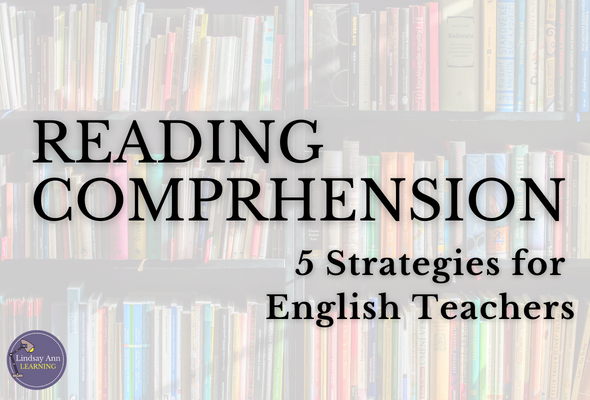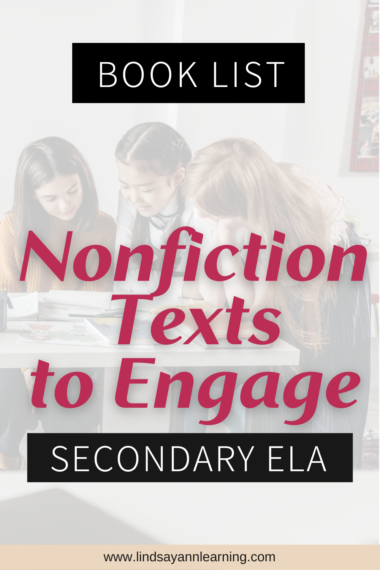When I Netflix and relax, I’m not thinking about reading with comprehension, but I always turn the captions on, reading that bold white text over the action on the screen–words on top of explosions that rattle the room, sentences overlaying embraces between characters, literal punctuation punctuating the proclamations of actors–as I find that helps me engage with what I’m seeing.

If it wasn’t for reading along with the captions, my mind would drift. I’d pick up my phone. I’d “multitask,” paying half-attention to everything. But, with the words on the screen, I find I’m using strategies when reading.
I’m drawing inferences about characters’ emotional states as I see their short, clipped sentences of dialogue.
I’m predicting and anticipating what’s next after the “haunting music” swells.
In short, I’m using reading strategies, which is what good readers do and what we, of course, want our students to do when they encounter visual or written texts.
So how can we get students to use strategies when reading?
Perhaps, first, we need to help them understand why reading comprehension is important.
- Start by giving students a challenging text, with no context and no preparation. For example, for a visual text, give students a sculpture to view and analyze like Northern Illinois University’s “Balance of Equality.” Without context–namely where it is, what it honors, what critics have said about it, etc.–have students work to make meaning of it using their reading comprehension skills.
- Then, with that prompt, students might begin by noticing things: the hourglass shape, the different colors, the plants, etc. What are they doing as readers? They are taking steps to analyze the author’s craft, noticing the way the author (in this case the sculptor) is using different elements to communicate meaning (which is much like what a writer does on the page).
- Students might ask questions: Why is it shaped like an hourglass? Why are the colors and patterns on top different from on the bottom? Why are there gaps in the stone on top? Here students are asking questions about the text to better understand the author and the meaning of the text.
- Give students some context for the sculpture–such as it’s based on Martin Luther King Jr.’s “Christmas Sermon on Peace”–and let students make connections from text-to-text or text-to-world: What themes run through both sculpture and sermon? How does the sculpture honor MLK Jr.?
All of a sudden, for students, they go from seeing a hunk of concrete and color to analyzing and interpreting a piece of artwork, unlocking its meaning and upping their appreciation of it. And how’d they do this? By reading with comprehension, using their reading comprehension skills of course! This will help readers see how using strategies when reading helps their reading comprehension levels.

Once students understand what reading comprehension is and why it’s important, we can work with students to give them reading comprehension practice. Below are some reading comprehension exercises you can try with your students in the classroom to give students reading comprehension practice.
Reading Comprehension Exercises – Visualizing
Reading with comprehension is helped by visualizing while reading. If students can roll a movie in their head while they read, they are more likely to understand what they are reading. To help with this, you can ask students to look for sensory details, figurative language, vivid verbs, and literal details about characters and setting. All of these help shape the movie we stage in our heads as we are reading with comprehension.
Here are some reading comprehension activities you can use to help students visualize a text:
- Jigsaw the pages in a text, asking students to highlight or sticky note moments–words, sentences, paragraphs–that evokes a visual in their minds as readers. Students can then share a summary of the visuals from their page, connecting those visuals to the pages that come before and after. Page-by-page, then, students will build a visual summary, frame-by-frame, together to help improve reading comprehension.
- Ask students to debate with one another the most powerful image on a page or in a chapter and then discuss with the class what they learn about the characters, the setting, and/or the theme from the visual.
- Introduce students to AI-generated artwork like OpenAI’s Dall-E and have them input an important passage or individual sentences into it to see what the artificial intelligence creates. From here, students could discuss the degree to which the visual matches the text and the extent to which the image helps them reading with comprehension. Students could also tweak the input to better match the visual the text evokes. (For example, would a passage describing Lennie from Of Mice and Men be best in an Art Deco or Abstract Expressionism style?)
Reading Comprehension Exercises – Summarizing

Reading with comprehension is also helped by summarizing while reading to help students determine what’s important. If students can accurately summarize what they’ve read, they know they’ve understood what they read. However, if they cannot summarize what they’ve read, it’s a good indicator they are having reading comprehension difficulties.
Here are some reading comprehension activities to help students summarize a text:
Idea #1: Ask students to pick out the most important page, paragraph, sentence, and then word in a reading. From here, ask students to summarize what happens on that page, in that paragraph, in that sentence, and then around that word. If a student shares this with you, then, you can conduct a reading comprehension assessment, checking to see if the student was able to understand the most important parts of the reading.
Idea #2: Tell students they have one word per paragraph to use to describe what happens in each paragraph. They can write this word in the margins or on a sticky note. At the end of each page, then, students could stitch together a summary of what happened using these few words in their summary.
Idea #3: Give students a printed out, but modified, summary of a text or one of its chapters. Modify the summary by either cutting out individual words or sentences, so students–after reading–have to fill in the blanks to create accurate summaries of their reading, or modify the summary by adding incorrect details or information from later chapters, so students–after reading–have to correct the summary.

Reading Comprehension Exercises – Predicting
At this point, you might predict you are nearing the end of this blog as you’ve scrolled through several sections and learned about reading comprehension strategies. And you are correct–but let’s touch on making predictions as a way to improve one’s reading with comprehension before we part ways for today.
Many students predict–but it’s really the process of prediction that’s more important than the prediction itself. In the end, in other words, whether their prediction is right or wrong matters less than the evidence and inference that led to their predictions.

Here, then, are some ideas of how we can help students better appreciate the prediction process:
- Give students, at a crossroads in a text, two or three possible outcomes or predictions. Ask students to identify which–if any–of these predictions is possible based on the current evidence they have from the text.
- Have students brainstorm other texts they’ve read and movies they’ve watched in a genre that they’re currently reading. (For example, if they are reading The Hunger Games, what other dystopian or post-apocalyptic stories have they encountered?) Students can frame their brainstorming around how stories were resolved, how characters grew, how conflicts were untangled, etc. From here, students could discuss a current text they’re reading through the lens of what they’ve read already. For example, in many post-apocalyptic stories, the characters face survival challenges related to resource management. Do students predict the characters in this text will face this same challenge? Using this prediction strategy, students can see the ways their current text follows, breaks, or tweaks genre conventions and tropes.
- Play if-then with students while reading a text. You (or the students) could create an if-statement and then have students discuss possible then-outcomes. (For example, if the Man in Cormac McCarthy’s The Road dies, then the Boy . . . .) Students could then defend their “then’s” with the text.
Teaching Reading Skills
With the reading comprehension activities above, students will have some of the reading comprehension help they need to succeed as readers.
In the era of AI-generated summaries SparkNotes, it’s all the more important that students encounter texts that challenge them, asking them to use reading comprehension strategies and skills. It’s this hard, necessary work that will help our students grow as readers–regardless of what they are reading, whether it’s a question on the SAT or a caption on their favorite Netflix show. Netflix and chill? Nope. Netflix and reading comprehension skills? Yes, indeed!















 The Importance of Active Reading and How to Do It
The Importance of Active Reading and How to Do It
I greatly enjoyed your article and your literary style! Looking forward to reading more of your articles.